Disclosure: We may earn commissions if you purchase products after clicking on a link from our site.
Do you want to learn how to catch bullfrogs? Do you want to go frog gigging? Catching bullfrogs can be challenging as they are slippery to catch and use the strength of their hind legs to escape if you try to catch them by hand.
However, frog gigging can be fun and rewarding if you intend to have a meal with chewy frog legs. In this article, we discuss how to catch bullfrogs.
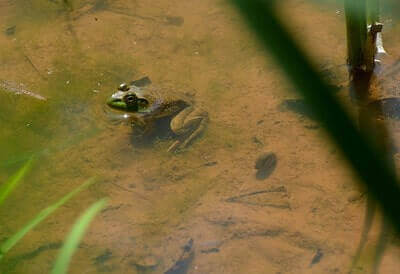
Table of Contents
Tools
- Frog Gig
A frog gig is a specialized tool commonly used by hunters to catch frogs, particularly in shallow waters or areas with dense vegetation. It consists of a long pole typically made of wood or metal, with a multi-pronged spear attached to one end. The spear’s prongs are sharp and barbed, designed to impale frogs swiftly and securely upon contact.
Hunters often venture out at night equipped with a flashlight or headlamp to spot frogs along the water’s edge. Using the frog gig requires precision and skill, as hunters must maneuver through the water stealthily and accurately target frogs to spear them. The design of the frog gig allows hunters to capture frogs without causing unnecessary harm, ensuring a humane and efficient method of harvesting.
However, hunters need to adhere to local regulations and guidelines regarding the use of frog gigs, as some areas may have restrictions on equipment or species that can be harvested. For more information on frog gigs and frog hunting techniques, individuals can refer to resources provided by authoritative sources such as state wildlife agencies.
2. Flashlight
A flashlight is a valuable tool for frog hunters, especially when venturing out at night to catch frogs. Equipped with a bright beam of light, a flashlight helps hunters illuminate the surrounding environment, making it easier to spot frogs along the water’s edge or in dense vegetation.
By directing the light towards potential hiding spots such as ponds, streams, or marshy areas, hunters can detect the reflective eyeshine of frogs, which often appears as a glowing pair of eyes in the darkness. Additionally, a flashlight provides visibility and safety for hunters as they navigate through uneven terrain and murky waters.
Some frog hunters also use specialized headlamps that allow for hands-free operation, enabling them to wield other tools or equipment, such as frog gigs, with ease. Overall, a flashlight serves as an essential tool for frog hunting, enhancing visibility and aiding hunters in locating and capturing their prey effectively.
However, hunters should be mindful of local regulations regarding the use of artificial lights for hunting frogs, as some areas may have restrictions to protect wildlife or minimize disturbance to nocturnal ecosystems. For more information on frog hunting techniques and equipment, individuals can consult resources provided by authoritative sources such as state wildlife agencies.
3. Headlamp
A headlamp is a practical and convenient tool for frog hunters, particularly those who venture out at night to catch frogs. Unlike handheld flashlights, headlamps provide hands-free illumination, allowing hunters to focus both their attention and their hands on the task at hand.
Equipped with adjustable straps, headlamps securely attach to the hunter’s head or helmet, providing a stable and comfortable light source that moves with them as they navigate through various terrains. This feature is particularly beneficial when traversing uneven or slippery surfaces near bodies of water, where visibility may be limited.
With their powerful LED bulbs, headlamps emit bright beams of light that penetrate the darkness, making it easier for hunters to spot frogs hiding in vegetation, along shorelines, or in shallow water. Additionally, headlamps with adjustable brightness settings offer versatility, allowing hunters to tailor the intensity of the light to suit different hunting conditions and preferences.
Some headlamp models also feature red light modes, which are less likely to startle frogs or disturb their natural behaviors compared to white light. Overall, a headlamp is an indispensable tool for frog hunters, providing hands-free illumination, enhanced visibility, and increased safety during nocturnal hunting expeditions. As with any hunting equipment, hunters should ensure they are using headlamps responsibly and in compliance with local regulations to minimize disturbance to wildlife and natural habitats.
4. Container
A container is an essential item for catching frogs, providing a safe and temporary holding space for captured specimens during a frog hunting expedition. These containers come in various shapes and sizes, ranging from small handheld jars to larger buckets or coolers, depending on the hunter’s preference and the quantity of frogs being caught.
Transparent or translucent containers are commonly used, allowing hunters to easily observe the frogs inside without needing to open the container frequently. Additionally, containers with secure lids or covers are crucial to prevent captured frogs from escaping, especially if they are kept alive for later release or culinary purposes.
Some containers may feature perforated lids or sides to ensure adequate ventilation while minimizing the risk of frogs jumping out. When catching frogs, hunters should handle them gently and avoid overcrowding the container to prevent injury or stress to the captured specimens. It’s also important to provide a moist environment within the container by adding damp vegetation or a shallow layer of water to keep the frogs hydrated and comfortable.
Properly equipped with a suitable container, frog hunters can effectively and responsibly capture frogs while minimizing harm to both the animals and their habitats. As with any hunting activity, individuals should familiarize themselves with local regulations and ethical practices regarding frog collection and transportation to ensure sustainable and responsible frog hunting practices.
5. Cast Net
A cast net, although primarily designed for catching baitfish and other aquatic creatures, can also be a highly effective tool for catching frogs in certain environments. This versatile net consists of a circular mesh attached to a series of weighted lines, enabling users to cast the net over a wide area and quickly gather potential prey.
When targeting frogs, hunters typically look for shallow, slow-moving bodies of water such as ponds, marshes, or streams with ample vegetation and frog habitat. Using a cast net to catch frogs involves skillfully casting the net into the water near areas where frogs are likely to be found, such as along the water’s edge or among aquatic vegetation.
The weighted lines of the net sink quickly, trapping any frogs within the spread of the net as it sinks to the bottom. Once the net has settled, hunters gently pull the lines to draw the net closed, capturing any frogs caught within its radius. It’s essential to approach frog-catching with caution and respect for both the frogs and their habitat, ensuring that captured frogs are handled gently and released unharmed if not intended for consumption.
Additionally, individuals should familiarize themselves with local regulations regarding the use of cast nets for frog hunting and obtain any necessary permits or licenses required for recreational frogging activities. By employing a cast net with skill and care, hunters can effectively capture frogs while minimizing harm to both the animals and their aquatic environment.
How To Catch Bullfrogs
1. Frog Season
One of the first things you want to know is when is the frog season in the area you want to go frog gigging. There are a few states that allow year-round hunting of bullfrogs, but most states have a frog season that you have to adhere to. You want to abide by the laws regarding hunting bullfrogs.
Additionally, there may be a limit to the number of bullfrogs that anyone can take home in one day. You want to be aware of all the rules and regulations concerning hunting bullfrogs.
2. Hunting Method
You will have to decide on the hunting method to use when frog gigging. Will you use a gig to hunt bullfrogs, a cast net, or use your hands to catch them? Using your hands is the least favorable method since bullfrogs’ skins are slippery and some bullfrogs carry diseases that can be easily transmitted to humans.
A cast net can also be used to catch bullfrogs. This is a cumbersome but safe hunting method for catching bullfrogs. It is usually used if you intend to keep the bullfrogs in an aquarium rather than eating them. Using a gig is one of the popular methods of hunting bullfrogs.
A frog gig is a tool that is made of a long rod with prongs at the end to pierce and catch bullfrogs. Using frog gigs is one of the popular methods of catching bullfrogs especially if you intend to eat them.
A. Gigging
Gigging is another popular method used to catch frogs, particularly in areas with shallow waters or dense vegetation. This technique involves using a specialized tool called a frog gig, which consists of a long pole with a multi-pronged spear at the end.
Hunters typically venture out at night equipped with a flashlight or headlamp to spot frogs along the water’s edge. Using the gig, hunters carefully maneuver through the water, aiming to impale frogs with the sharp prongs.
Gigging requires precision and skill to accurately target and spear frogs without causing unnecessary harm. Hunters must adhere to local regulations and guidelines regarding gigging, as some areas may have restrictions on the equipment or the species that can be harvested. For more information on gigging and frog hunting regulations, individuals can consult resources provided by authoritative sources such as state wildlife agencies.
B. Hand Capture
Hand capturing frogs is one of the most common and traditional methods used by hunters. This method involves quietly approaching frogs in their natural habitat and swiftly grabbing them with bare hands. Hunters often venture out to marshes, ponds, or wetlands during the evening or nighttime when frogs are most active.
With careful movements and a keen eye, hunters can easily spot frogs resting near the water’s edge or hopping around. It’s essential to move slowly and avoid sudden movements to prevent scaring away the frogs. Once within reach, hunters can quickly grasp the frog behind its front legs to capture it safely.
Hand capture requires patience and stealth but can be a rewarding and environmentally friendly way to catch frogs. For more information on hand capturing frogs and other hunting techniques, individuals can refer to resources provided by authoritative sources such as the U.S. Fish and Wildlife Service (USFWS).
C. Trapping
Trapping is a passive method used to catch frogs, allowing hunters to set up traps and wait for frogs to enter and be captured. Various types of traps can be used for frog trapping, including funnel traps, hoop traps, and minnow traps modified with mesh or wire to accommodate frogs.
Hunters typically bait the traps with enticing food items such as insects, worms, or pieces of meat to attract frogs. Once frogs enter the trap to feed, they become confined inside, allowing hunters to retrieve them later. Trapping can be an effective method for catching frogs in areas where other techniques may not be feasible, such as deep water or dense vegetation.
It’s essential for hunters to regularly check their traps to ensure the humane treatment of captured frogs and comply with regulations regarding trap placement and use. For more information on trapping frogs and ethical trapping practices, individuals can refer to resources provided by authoritative sources such as the U.S. Geological Survey (USGS).
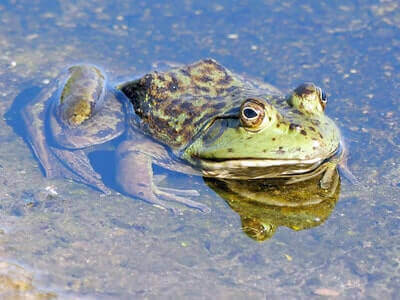
3. Hunting Tools
The hunting method will determine the tools you will use for hunting bullfrogs. A frog gig, a cast net, a very bright and powerful flashlight or headlamp, and a container.
4. Frog Habitat
Frogs like to reside in ponds, marshes, streams, rivers, and freshwater lakes. Frogs like areas with vegetation, cattails, tree canopy, and very little current. This allows them to use the vegetation for cover and reside in the water with no current to deal with.
5. Day or Night Hunt
Frogs can be caught during the day or night. Most frog hunters prefer to hunt frogs at night. Frogs usually get active at night and make loud sounds during the night. This makes it easier to locate them from the loud noise the males make.
Additionally, their eyes illuminate when light hits it and this puts them in a trance like a deer before in the headlights. This is referred to as “jacking”.
This trance that they go into is advantageous for the frog hunter as you can use this time to either gig them or grab them firmly with your hand. Bullfrogs can also be caught during the day using a cast net, your hands, or a gig. However, most frog hunters prefer hunting them at night.
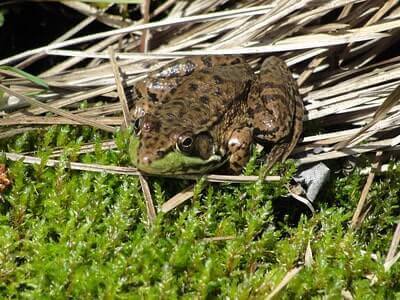
6. Move Slowly and Quietly
Move lightly and quietly if you are walking on the banks of ponds, streams, or rivers during the night. Frogs can pick up the vibrations and will quickly jump away. If you are in a canoe, don’t let the paddle hit its side as the noise will make frogs leave.
How To Catch Bullfrogs During The Day
Bullfrogs can be caught during the day even though most bullfrog hunters prefer the night. Most bullfrog hunters that hunt during the day use their fishing rods with bait on a small treble hook. Frogs eat almost anything including mice, insects, snakes, fish, and toads.
When the bullfrogs go for the bait, they take the hook in as well and this hooks them. A frog gig can also be used to hunt bullfrogs during the day.
How To Hunt Bullfrogs In A Boat
Bullfrogs can also be hunted in a boat. Many frog hunters use a frog gig when hunting from a boat. Others prefer using their hands to catch the frogs because they can quickly release them if it is small. A cast net can also be used to catch bullfrogs when hunting from a boat.
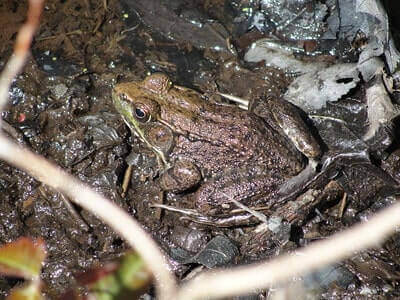
How To Hold A Bullfrog By Hand
When holding a bullfrog, you need to hold it firmly around the upper thighs with its legs together. This grip makes it difficult for it to escape. Bullfrogs have a slippery skin and their hind legs are very powerful.
How To Butcher a Bullfrog
Tools
- Sharp Knife
A sharp knife is an essential tool for butchering frogs efficiently and safely. When preparing frogs for consumption, hunters often use a sharp knife to swiftly and accurately remove the legs, which are the most prized and commonly consumed part of the frog.
A sharp knife allows for precise cuts, minimizing unnecessary damage to the meat and ensuring a clean separation from the rest of the frog’s body. Additionally, a sharp knife makes it easier to skin and clean the frog legs, removing any unwanted skin or innards before cooking. Proper knife handling techniques are crucial to ensure safety and prevent accidents during the butchering process.
It’s essential to use a knife with a secure grip and to maintain control over the blade at all times, especially when working with small and delicate frog specimens. After use, the knife should be carefully cleaned and stored to maintain its sharpness and prevent corrosion.
Overall, a sharp knife is indispensable for efficiently and effectively butchering frogs for consumption, making it a valuable tool for hunters and culinary enthusiasts alike. For comprehensive guidance on frog butchering techniques and knife safety practices, individuals can refer to educational materials provided by reputable sources such as wildlife management agencies and culinary experts.
2. Cutting Board
A cutting board is a fundamental tool used when butchering frogs, providing a stable and sanitary surface for preparing the meat. Whether filleting fish or trimming meat, a cutting board offers a flat, elevated platform that protects both the meat and the underlying work surface.
When processing frogs, a cutting board prevents cross-contamination by creating a designated area solely for meat preparation. It helps maintain hygiene standards by facilitating easy cleanup and disinfection after use. Additionally, a cutting board provides a firm base for wielding knives, ensuring precise cuts while reducing the risk of accidental injuries.
The material of the cutting board is crucial, with options including plastic, wood, and composite materials. Each has its advantages; for example, plastic cutting boards are dishwasher-safe and easy to sanitize, while wooden cutting boards offer natural antibacterial properties and are gentler on knife blades. Overall, a cutting board is an indispensable tool in the frog butchering process, promoting cleanliness, safety, and efficiency.
3. Needlenose Pliers
Needle-nose pliers are versatile tools that can be invaluable when butchering frogs. These long, slender pliers feature tapered jaws that come to a fine point, making them ideal for precise and delicate tasks. When preparing frogs for cooking, needlenose pliers can be used to grip and remove small bones, such as rib bones or those found in the legs.
Their narrow jaws enable users to access tight spaces and grasp tiny bones or cartilage without damaging the surrounding meat. Additionally, needlenose pliers can be handy for removing unwanted tissue, such as tendons or sinew, from frog legs, ensuring a cleaner and more enjoyable eating experience. Their ergonomic design provides a comfortable grip, reducing hand fatigue during prolonged use.
Moreover, needlenose pliers are durable and corrosion-resistant, making them suitable for use in various environments, including wet or humid conditions often encountered during frog butchering. Whether used by professional chefs or home cooks, needlenose pliers are an essential tool for precise and efficient frog preparation. Guidance on the proper use and maintenance of needlenose pliers can be found from reputable sources such as government occupational safety agencies and DIY experts.
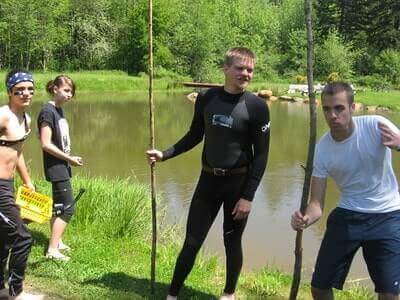
1. Wash the Bullfrog
Washing the frog is a crucial step in the process of butchering it, ensuring that the meat is clean and safe for consumption. After removing the skin and internal organs, rinsing the frog thoroughly under cold running water helps to remove any remaining blood, debris, or impurities from the meat surface.
This step not only improves the appearance and taste of the meat but also reduces the risk of contamination by bacteria or pathogens. Using clean hands or utensils, gently rub the frog meat to ensure that all surfaces are properly cleaned.
Some individuals prefer soaking the frog meat in cold water for a few minutes to further enhance cleanliness and remove any lingering odors. Proper hygiene practices, including washing hands and utensils before and after handling the frog, are essential to prevent cross-contamination.
Additionally, following guidelines from reputable sources such as government health agencies ensures food safety and reduces the risk of foodborne illness. By washing the frog thoroughly during the butchering process, individuals can enjoy delicious and nutritious frog meat with confidence.
2. Place on Board
Placing the frog on a board is a fundamental step in the process of butchering it efficiently and safely. After catching or obtaining the frog, it is essential to have a clean and stable surface to work on, such as a cutting board or a sturdy table. This provides a stable platform for handling and preparing the frog for consumption.
Carefully positioning the frog on the board ensures better control during the butchering process, allowing for precise cuts and minimizing the risk of injury. Placing the frog belly-side down or back-side up, depending on the preferred method of butchering, allows for easier access to the skin and internal organs.
It’s essential to ensure that the board is clean and sanitized before placing the frog to prevent contamination of the meat. Using a sharp knife and following proper techniques, such as holding the frog firmly and making controlled cuts, individuals can efficiently remove the skin and organs while minimizing waste.
This step sets the stage for further processing, including cleaning, washing, and cooking the frog meat to enjoy as a delicious and nutritious dish. Following food safety guidelines and proper handling practices ensures the quality and safety of the final product, allowing for a satisfying culinary experience.
3. Cut Off the Feet
Cutting off the feet of the frog is a crucial step in the process of butchering the frog for consumption. After placing the frog on a clean and stable surface, such as a cutting board, the feet are typically removed to facilitate further processing. Using a sharp knife, the feet are carefully severed from the legs at the joint.
This step is essential as the feet contain little meat and are often discarded. Removing the feet also allows for easier access to the frog’s legs, which are the primary edible portion of the frog. By cutting off the feet, individuals can streamline the butchering process, making it more efficient and manageable.
Additionally, discarding the feet helps ensure that only the highest-quality meat is used for consumption. Properly disposing of the feet also helps maintain cleanliness and hygiene throughout the butchering process.
Once the feet are removed, the frog can be further cleaned, washed, and prepared according to the desired recipe. Following these steps ensures the safe and effective butchering of the frog, resulting in delicious and nutritious frog legs ready for cooking and enjoyment.
4. Slice Skin Around Waist
Turn it over so that its back is on the cutting board and the bottom is facing you. Use kitchen shears or a sharp knife to slice the skin around the waist as if you gave it a belt. Once you have cut the skin completely around the waist of the bullfrog, turn it back so that its stomach is lying flat on the cutting board.
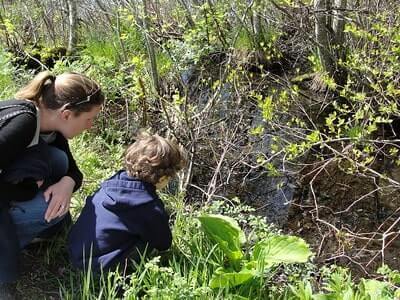
5. Pull the Skin Off
Holding the head and upper part of the bullfrog with one hand, use the other hand to pull the skin from the bullfrog using pliers. it will tear off the frog-like you are pulling off its pants.
7. Tidy Up
Cut off any little bits that you don’t want on the legs so they look clean and neat for grilling or cooking.

How To Cook A Bullfrog
There are many ways to cook a bullfrog. You can grill it, smoke it, bake it, or cook it. Apply salt, black pepper, garlic, onions, and other spices to the frog legs. Then you can grill them on low heat, smoke, bake, or cook them.
Frog Gigging Tips
- Use a bright and powerful flashlight or headlamp to direct the light into the eyes of bullfrogs. This puts them in a trance allowing you the time to gig them or grab them firmly with your hand. This technique is referred to as “jacking”.
2. Bullfrogs eat almost anything and you can use mice, insects, and toads as bait to catch bullfrogs with your fishing rod.
3. When hunting for bullfrogs during the night, if you notice the eyes are big and wide apart from each other, that indicates that it is a big and mature bullfrog.

4. When hunting bullfrogs in ponds, streams, marshes, rivers, and lakes, be on the lookout for dangerous snakes and alligators.
5. Always check your state for the rules and regulations regarding the hunting of bullfrogs.
6. If you are hunting bullfrogs from the banks of ponds, streams, marshes, and rivers, walk lightly and quietly as bullfrogs can pick up the vibration and will escape to safety.
7. Using a canoe, you can quietly move into marshes and shallow water looking for bullfrogs.
8. Most bullfrog hunters go at night since it is easier to locate them.
The Bottom Line
Small game hunting is not only exciting but also rewarding. Learning how to catch bullfrogs is one that most hunters like to do during the frog hunting season. It is not as challenging as hunting other small or big game animals.
In this article, we discussed how to catch bullfrogs, the hunting methods, the equipment you need, and other information. if you want to improve your small game hunting tips, then read this article.